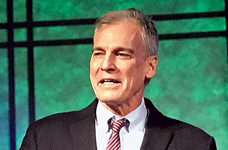
Although not as optimistic as at the start of the year, facility census conditions give reason for encouragement, the leader of the nation’s largest nursing home association believes.
The next three months, however, will be critical in determining the fate of the nation’s 15,000-plus skilled nursing facilities, said Mark Parkinson, president and CEO of the American Health Care Association.
“We were making really good, steady progress to recovering census until the delta variant hit and since then, we’ve had a pause in the recovery. We’ve not had a retreat, and I think that’s encouraging,” Parkinson told McKnight’s Long-Term Care News on Friday.
“If we would have had another 3% or 4% drop with delta, we’d be in much worse shape than right now,” he added. “We’ve hit a plateau at about 72% nationwide, and now we have to start building back.”
In February, Parkinson said facilities needed to gain about 1% in census monthly over the next year or it would have “a real problem.” In January and February, nursing homes were regaining 0.8% to 1% in census per month.
“We were well on our way to financial stability by the end of 2021,” he recalled Friday. “Then delta hit. We’ve gone from 67.5% to 72.5%. We still have 7% to go. We’ve been in a pause for the last six weeks. The good news is we haven’t fallen back, thank God.”
Each Thursday, updated census figures are delivered by the Centers for Disease Control and Prevention’s National Healthcare Safety Network (NHSN). Last week saw a 0.2% upward nudge after two weeks of 0.1% declines.
“If we can get back to the trajectory we were on before delta, we could end the year in the 75% range. The sector wouldn’t be back to complete health, but we’d be at the point where we can see light at the end of the tunnel,” Parkinson said.
“Then the hope would be we would continue to recover at that pace so by mid-2022, we would be back at pre-pandemic levels. That’s really the best-case scenario at this point. It’s not great, but we can survive that.”
A continued pause or retraction would mean “real problems,” he emphasized.
He said COVID-19 infections need to continue to decline in the general population so that hospitals could perform more elective procedures, which would result in more skilled nursing facility admissions and better revenue flow.
“We need life to come back to normal. I think that’s probable,” Parkinson said measuredly. “It would be ridiculous to be certain about that because this virus has proven to be unpredictable. But the trajectory seems good. It really feels like almost every week there’s good news.”
The second need is for staffing conditions to improve, Parkinson said. Just as census levels hit historic lows during the pandemic, the industry is now struggling to find workers — more so than ever. Many facilities recently have been unable to accept new residents due to historically low staffing levels, Parkinson pointed out, and some have announced closures.
“Continued support” needs to come from state and federal agencies, he added. That could help create competitive wages and build career paths. “If we don’t get that aid, we just can’t be competitive,” he explained.
A silver lining, he reminded, is that the demographics haven’t changed.
“As gloomy as it has appeared at times during COVID, the bright side is there are a lot of people turning 80 who are going to need our services,” Parkinson said. “The number of units on the skilled nursing side is declining, so if we can get past this very, very rough past year and half and what’s likely to be a very rough nine to 12 months, we’re going to be fine.”




